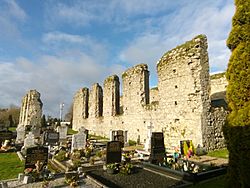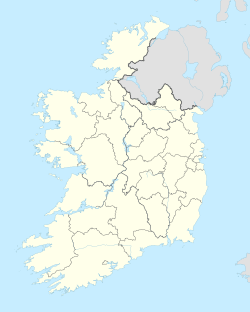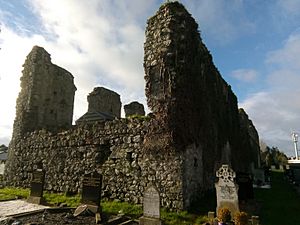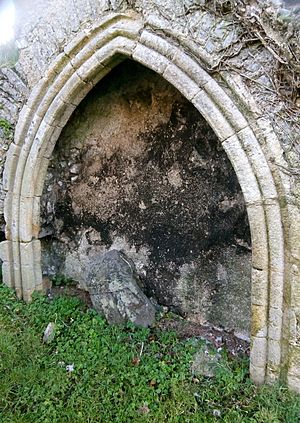Clane Friary facts for kids
| Mainistir Chlaonadh | |

Remains of the abbey church
|
|
| Monastery information | |
|---|---|
| Other names | Cloenath; Claenath; Claenad; Claona; Cleonad; Cloney; Cluain |
| Order | Order of Friars Minor Conventual |
| Established | c. 520; 1258 |
| Disestablished | c. 1560 |
| Diocese | Kildare |
| People | |
| Founder(s) | Ailbe of Emly |
| Architecture | |
| Status | ruined |
| Style | Norman |
| Site | |
| Location | Abbeyland, Clane, County Kildare |
| Coordinates | 53°17′21″N 6°40′59″W / 53.289256°N 6.683023°W |
| Public access | yes |
Clane Friary, also known as Clane Abbey, was once a home for Franciscan friars. It is located in Clane, County Kildare, in Ireland. Today, only ruins remain of this historic place.
Contents
Where is Clane Friary?
Clane Friary is found just southeast of Clane village. It is north of King Mesgegra's Mound and the River Liffey.
A Look Back: History of Clane Friary
Clane is thought to get its name from Claon-áth, which means "crooked ford." It started as an early Irish monastery.
Early Beginnings (Around 520 AD)
People believe that Saint Ailbe of Emly first founded a monastery here around the year 520 AD. Another important leader, Secundinus, became its second abbot. In the 500s and 600s, the monks from Clane helped spread Christianity. Sadly, in 1035, Vikings attacked and robbed the monastery.
Important Meetings (Synods)
The monastery continued to be an important place. In 1162, Clane hosted a very big meeting called the Synod of Clane. Important church leaders, including Gelasius of Armagh and Lorcán Ua Tuathail (who later became Saint Laurence O'Toole), attended. At this meeting, they made a rule that only those trained in Armagh could become a "lector" (someone who reads lessons in church).
The Franciscans Arrive (1258 AD)
Later, around 1258, Gerald FitzMaurice FitzGerald started a new home for the Franciscan friars at Clane. He was buried there in 1259. You can still see a small piece of his tomb today.
In 1345, the Franciscans held another important meeting, called a "chapter," at Clane. The friary faced tough times around 1348-1350 because of the Black Death, a terrible sickness. However, some new parts were added to the buildings in the late 1300s. Families like the Hogans and Wesleys often had members who served as leaders or monks at the abbey.
The Friary Closes (1540s)
The friary was officially closed down around 1540. At that time, it was not very big. It had about 70 acres of land, a church, a cemetery, a sleeping area (dormitory), a kitchen, two rooms, a stable, and an orchard. In 1541–42, the land was given to Sir Thomas Luttrell. Some of the friary buildings were torn down, and their stones were used to fix Maynooth Castle.
Later Years and Final Abandonment
Even after the official closure, some friars secretly stayed at Clane until the buildings were completely destroyed around 1606. A few friars still remained hidden in the area. Clane Friary was briefly brought back to life in 1647 but was finally abandoned in 1650. Today, Franciscan friars still visit Clane each year to celebrate Mass on a special day called the Feast of the Portiuncula.
What the Building Looked Like
The church at Clane Friary was about 43 meters (141 feet) long from east to west and 8 meters (26 feet) wide from north to south. It had a main area (nave) and a special area near the altar (chancel). In the 1400s, a south aisle (a side section of the church) was added. You can still see some decorative carvings (moulding) and special seats for priests (sedilia). There is also a stone carving (effigy) of Gerald FitzMaurice FitzGerald, who founded the Franciscan part of the friary.
Images for kids







